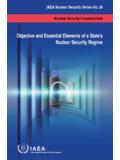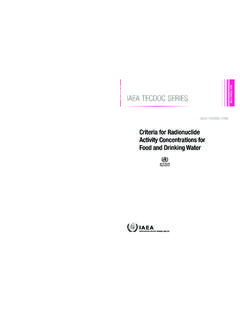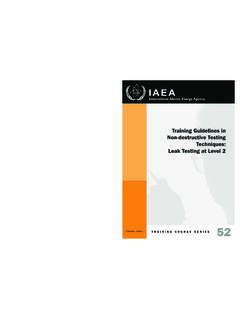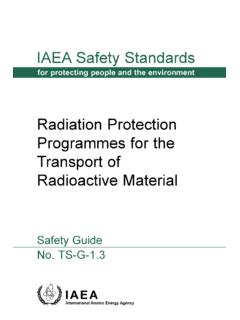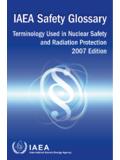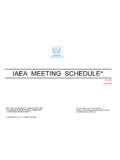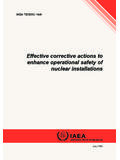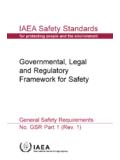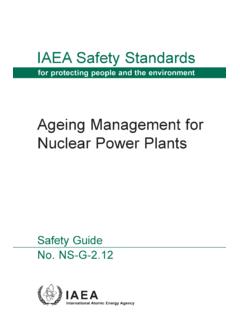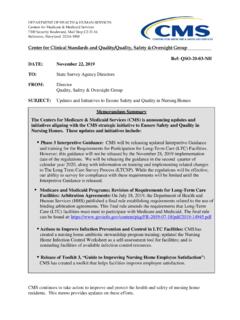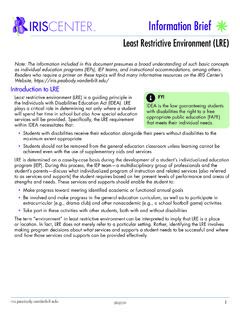Transcription of Dosimetry of Small Static Fields Used in External ... - IAEA
1 @Technical Reports SeriEs of Small Static Fields used in External Beam RadiotherapyAn International Code of Practice for Reference and Relative Dose Determination Sponsored by the IAEA and AAPM1 Dosimetry of Small Static Fields used in External Beam Radiotherapytechnical reportS series no. 483 IAEA SAFETY STANDARDS AND RELATED PUBLICATIONSIAEA SAFETY STANDARDSU nder the terms of Article III of its Statute, the IAEA is authorized to establish or adopt standards of safety for protection of health and minimization of danger to life and property, and to provide for the application of these publications by means of which the IAEA establishes standards are issued in the IAEA Safety Standards Series. This series covers nuclear safety, radiation safety, transport safety and waste safety. The publication categories in the series are Safety Fundamentals, Safety Requirements and Safety on the IAEA s safety standards programme is available on the IAEA Internet site provides the texts in English of published and draft safety standards.
2 The texts of safety standards issued in Arabic, Chinese, French, Russian and Spanish, the IAEA Safety Glossary and a status report for safety standards under development are also available. For further information, please contact the IAEA at: Vienna International Centre, PO Box 100, 1400 Vienna, Austria. All users of IAEA safety standards are invited to inform the IAEA of experience in their use ( as a basis for national regulations, for safety reviews and for training courses) for the purpose of ensuring that they continue to meet users needs. Information may be provided via the IAEA Internet site or by post, as above, or by email to PUBLICATIONSThe IAEA provides for the application of the standards and, under the terms of Articles III and of its Statute, makes available and fosters the exchange of information relating to peaceful nuclear activities and serves as an intermediary among its Member States for this on safety in nuclear activities are issued as Safety Reports, which provide practical examples and detailed methods that can be used in support of the safety safety related IAEA publications are issued as Emergency Preparedness and Response publications, Radiological Assessment Reports, the International Nuclear Safety Group s INSAG Reports, Technical Reports and TECDOCs.
3 The IAEA also issues reports on radiological accidents, training manuals and practical manuals, and other special safety related publications. Security related publications are issued in the IAEA Nuclear Security IAEA Nuclear Energy Series comprises informational publications to encourage and assist research on, and the development and practical application of, nuclear energy for peaceful purposes. It includes reports and guides on the status of and advances in technology, and on experience, good practices and practical examples in the areas of nuclear power, the nuclear fuel cycle, radioactive waste management and OF Small Static Fields used IN External BEAM RADIOTHERAPYAFGHANISTANALBANIAALGERIAANG OLAANTIGUA AND BARBUDAARGENTINAARMENIAAUSTRALIAAUSTRIAA ZERBAIJANBAHAMASBAHRAINBANGLADESHBARBADO SBELARUSBELGIUMBELIZEBENINBOLIVIA, PLURINATIONAL STATE OFBOSNIA AND HERZEGOVINABOTSWANABRAZILBRUNEI DARUSSALAMBULGARIABURKINA FASOBURUNDICAMBODIACAMEROONCANADACENTRAL AFRICANREPUBLICCHADCHILECHINACOLOMBIACON GOCOSTA RICAC TE D IVOIRECROATIACUBACYPRUSCZECH REPUBLICDEMOCRATIC REPUBLICOF THE CONGODENMARKDJIBOUTIDOMINICADOMINICAN REPUBLICECUADOREGYPTEL SALVADORERITREAESTONIAETHIOPIAFIJIFINLAN DFRANCEGABONGEORGIAGERMANYGHANAGREECEGUA TEMALAGUYANAHAITIHOLY SEEHONDURASHUNGARYICELANDINDIAINDONESIAI RAN.
4 ISLAMIC REPUBLIC OF IRAQIRELANDISRAELITALYJAMAICAJAPANJORDAN KAZAKHSTANKENYAKOREA, REPUBLIC OFKUWAITKYRGYZSTANLAO PEOPLE S DEMOCRATIC REPUBLICLATVIALEBANONLESOTHOLIBERIALIBYA LIECHTENSTEINLITHUANIALUXEMBOURGMADAGASC ARMALAWIMALAYSIAMALIMALTAMARSHALL ISLANDSMAURITANIAMAURITIUSMEXICOMONACOMO NGOLIAMONTENEGROMOROCCOMOZAMBIQUEMYANMAR NAMIBIANEPALNETHERLANDSNEW ZEALANDNICARAGUANIGERNIGERIANORWAYOMANPA KISTANPALAUPANAMAPAPUA NEW GUINEAPARAGUAYPERUPHILIPPINESPOLANDPORTU GALQATARREPUBLIC OF MOLDOVAROMANIARUSSIAN FEDERATIONRWANDASAN MARINOSAUDI ARABIASENEGALSERBIASEYCHELLESSIERRA LEONESINGAPORESLOVAKIASLOVENIASOUTH AFRICASPAINSRI LANKASUDANSWAZILANDSWEDENSWITZERLANDSYRI AN ARAB REPUBLICTAJIKISTANTHAILANDTHE FORMER YUGOSLAV REPUBLIC OF MACEDONIATOGOTRINIDAD AND TOBAGOTUNISIATURKEYTURKMENISTANUGANDAUKR AINEUNITED ARAB EMIRATESUNITED KINGDOM OF GREAT BRITAIN AND NORTHERN IRELANDUNITED REPUBLICOF TANZANIAUNITED STATES OF AMERICAURUGUAYUZBEKISTANVANUATUVENEZUELA .
5 BOLIVARIAN REPUBLIC OF VIET NAMYEMENZAMBIAZIMBABWEThe following States are Members of the International Atomic Energy agency :The agency s Statute was approved on 23 October 1956 by the Conference on the Statute of the IAEA held at United Nations Headquarters, New York; it entered into force on 29 July 1957. The Headquarters of the agency are situated in Vienna. Its principal objective is to accelerate and enlarge the contribution of atomic energy to peace, health and prosperity throughout the world .TECHNICAL REPORTS SERIES No. 483 Dosimetry OF Small Static Fields used IN External BEAM RADIOTHERAPYAN INTERNATIONAL CODE OF PRACTICE FOR REFERENCE AND RELATIVE DOSE DETERMINATIONINTERNATIONAL ATOMIC ENERGY AGENCYVIENNA, 2017 COPYRIGHT NOTICEAll IAEA scientific and technical publications are protected by the terms of the Universal Copyright Convention as adopted in 1952 (Berne) and as revised in 1972 (Paris).
6 The copyright has since been extended by the World Intellectual Property Organization (Geneva) to include electronic and virtual intellectual property. Permission to use whole or parts of texts contained in IAEA publications in printed or electronic form must be obtained and is usually subject to royalty agreements. Proposals for non-commercial reproductions and translations are welcomed and considered on a case-by-case basis. Enquiries should be addressed to the IAEA Publishing Section at: Marketing and Sales Unit, Publishing SectionInternational Atomic Energy AgencyVienna International CentrePO Box 1001400 Vienna, Austriafax: +43 1 2600 29302tel.: +43 1 2600 22417email: IAEA, 2017 Printed by the IAEA in AustriaNovember 2017 STI/DOC/010/483 IAEA Library Cataloguing in Publication DataNames: International Atomic Energy : Dosimetry of Small Static Fields used in External beam radiotherapy: an IAEA-AAPM International Code of Practice for reference and relative dose determination / International Atomic Energy : Vienna : International Atomic Energy agency , 2017.
7 | Series: Technical reports series (International Atomic Energy agency ), ISSN 0074 1914 ; no. 483 | Includes bibliographical : IAEAL 17-01121 | ISBN 978 92 0 105916 1 (paperback : alk. paper) Subjects: LCSH: Radiation Dosimetry . | Radiotherapy. | Radiotherapy Safety : UDC | STI/DOC/010/483 FOREWORDIn radiotherapy it is essential that the dose delivered to the patient be known accurately so that patients receive the correct amount of radiation to kill the cancer cells while at the same time sparing healthy tissue. Consistent reference Dosimetry traceable to metrological primary standards is key to the radiotherapy process and enables common procedures to be followed within a country. For conventional radiotherapy this has been achieved by universally adopted codes of practice such as the IAEA publication titled Absorbed Dose Determination in External Beam Radiotherapy: An International Code of Practice for Dosimetry Based on Standards of Absorbed Dose to Water (Technical Reports Series No.)
8 398) and the American Association of Physicists in Medicine (AAPM) publication titled AAPM s TG-51 Protocol for Clinical Reference Dosimetry of High-Energy Photon and Electron Beams. However, recent developments in radiotherapy have resulted in an upsurge in the use of Small Static photon beams such as those used in various forms of stereotactic radiotherapy, stereotactic body radiotherapy, stereotactic radiosurgery and intensity modulated radiotherapy. These radiotherapy treatments are performed not only with specialized , dedicated machines such as TomoTherapy , CyberKnife or Gamma Knife , but also with conventional, non-dedicated accelerators equipped with high resolution multileaf collimators. These developments have increased the uncertainty of clinical Dosimetry and weakened its traceability to reference Dosimetry based on codes of practice for conventional radiotherapy.
9 Accidents have occurred in some radiotherapy centres owing to the use of methods and procedures recommended in conventional codes of practice that are not applicable to Small Fields . This publication has been written in collaboration with the AAPM. It is the first Code of Practice dedicated to the Dosimetry of Small Static Fields used in radiotherapy and fulfils the need for a systematic and internationally unified approach to the Dosimetry of Small Static Fields . This Code of Practice is addressed to clinical medical physicists using Small Static photon Fields with energies less than 10 MV, provided with ionization chambers calibrated in terms of absorbed dose to water traceable to a primary standards Dosimetry laboratory. The IAEA wishes to express its gratitude to the authors and reviewers of this publication, in particular H. Palmans (Belgium), P.
10 Andreo (Sweden), M. Saiful Huq (United States of America) and J. Seuntjens (Canada). The IAEA officers responsible for this publication were S. Vatnitsky, A. Meghzifene and K. Christaki of the Division of Human IAEA and the AAPM wish to acknowledge the following people for their valuable suggestions:M. Aspradakis (Switzerland), H. Bouchard (Canada), G. Bruggmoser (Germany), S. Derreumaux (France), G. Ding (United States of America), D. Followill (United States of America), P. Francescon (Italy), F. Gomez (Spain), D. Gonzalez-Casta o (Spain), S. Kim (United States of America), M. McEwen (Canada), C. Reft (United States of America), F. Sanchez-Doblado (Spain), Sauer (Germany), T. Zhu (United States of America).EDITORIAL NOTEA lthough great care has been taken to maintain the accuracy of information contained in this publication, neither the IAEA nor its Member States assume any responsibility for consequences which may arise from its publication does not address questions of responsibility, legal or otherwise, for acts or omissions on the part of any provided here, describing good practices, represents expert opinion but does not constitute recommendations made on the basis of a consensus of Member mention of names of specific companies or products (whether or not indicated as registered)
